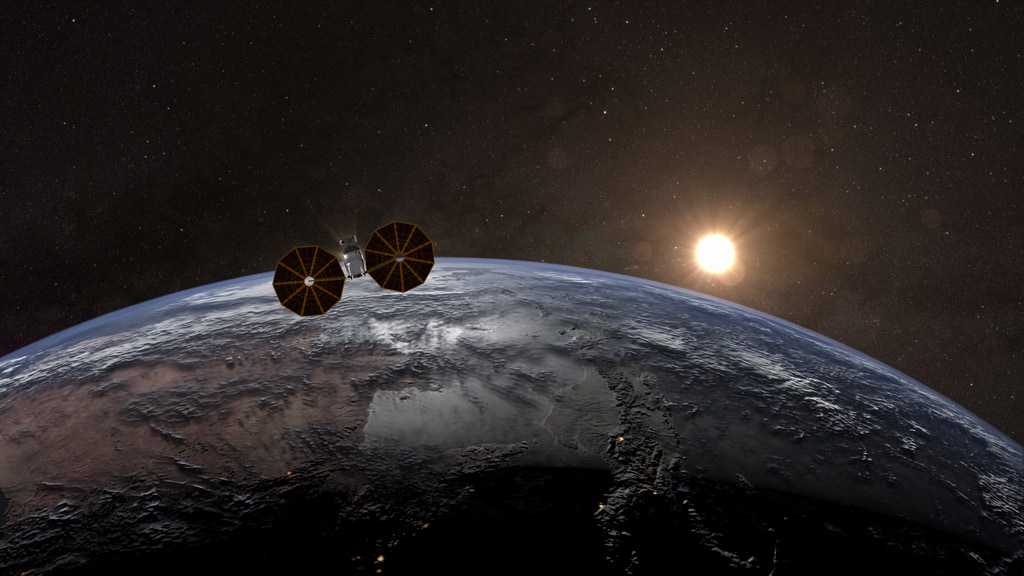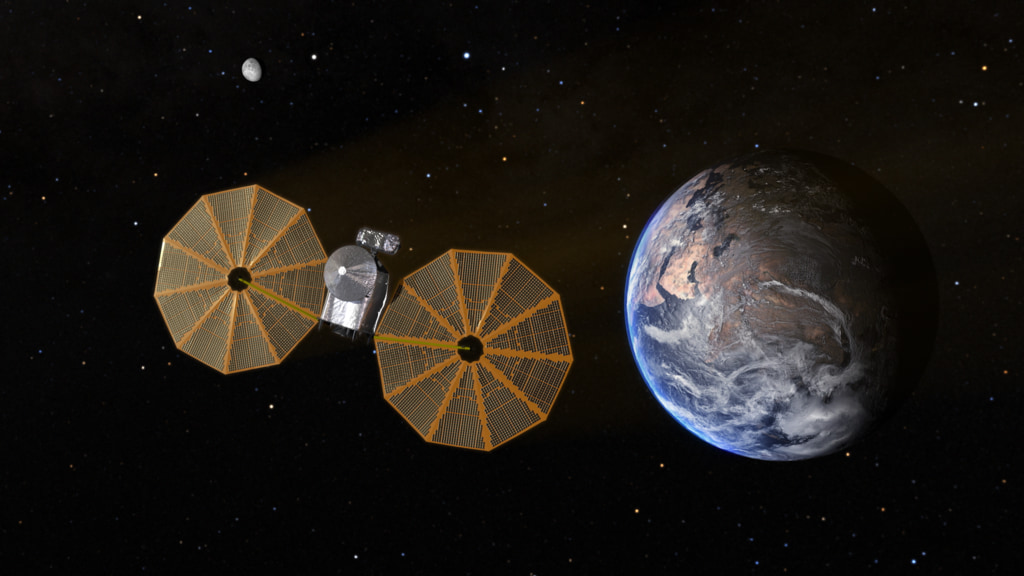Lucy Earth Gravity Assist Trajectory Visualizations
Ride-along view of Lucy’s first Earth gravity assist (EGA). The camera follows Lucy as the spacecraft approaches the sunlit side of Earth before crossing into Earth’s shadow as it slingshots around the planet.
NASA’s Lucy mission is heading to the Jupiter Trojans – two swarms of primitive asteroids trapped in Jupiter’s orbit that may hold clues to the formation of the planets. Lucy launched on October 16, 2021. After a year in orbit around the Sun, it is returning home on its launch anniversary for the first of three Earth gravity assists. On October 16, 2022, Lucy will fly by the Earth like a partner in a swing dance, boosting its speed and elongating its orbit around the Sun. At 7:04 am, Eastern Time, Lucy will make its closest approach at just 219 miles above the planet: lower than the International Space Station. This exceptionally close shave will increase its velocity by four-and-a-half miles per second, setting Lucy on track to gain even more speed when it returns to Earth for a second gravity assist in December 2024.
This visualization compares Lucy’s EGA1 trajectory (turquoise) with all active satellites (shown in white).
Top-down view of Lucy’s EGA1 trajectory with the Moon’s orbit.
A view of Lucy’s EGA1 trajectory over Australia
Ride-along view of Lucy’s first Earth gravity assist (EGA). The camera follows Lucy as the spacecraft approaches the sunlit side of Earth before crossing into Earth’s shadow as it slingshots around the planet. This is a slower version of the full ride along view above, focusing on the approach.
Ride-along view of Lucy’s first Earth gravity assist (EGA). The camera follows Lucy as the spacecraft approaches the sunlit side of Earth before crossing into Earth’s shadow as it slingshots around the planet. This is a slower version of the full ride along view above, focusing on the closest approach.
Credits
Please give credit for this item to:
NASA's Scientific Visualization Studio
-
Visualizer
- Kel Elkins (USRA)
-
Producer
- Dan Gallagher (KBR Wyle Services, LLC)
-
Scientist
- Katherine Kretke (SwRI)
Release date
This page was originally published on Thursday, October 13, 2022.
This page was last updated on Wednesday, August 14, 2024 at 10:45 PM EDT.
Datasets used
-
CelesTrak Spacecraft Orbit Ephemeris
ID: 454This dataset can be found at: http://celestrak.com
See all pages that use this dataset -
SPICE Ephemerides (SPICE Ephemerides)
ID: 755Satellite and planetary ephemerides
See all pages that use this dataset
Note: While we identify the data sets used on this page, we do not store any further details, nor the data sets themselves on our site.

![NASA’s Lucy spacecraft will make its second of three Earth gravity assists on Dec. 12, 2024.Complete transcript available.Universal Production Music: “Determined Arrival 4-5” by Joel Goodman [ASCAP]; “Floating” by Nicholas Smith [PRS]; “Subtle Confidence 3” by Joel Goodman [ASCAP]Watch this video on the NASA Goddard YouTube channel.](/vis/a010000/a014700/a014734/Lucy-EGA2-Preview-V4.jpg)
![Narrated video of Lucy’s encounter with the main-belt asteroid Dinkinesh and its satellite, Selam, on Nov. 1, 2023.Complete transcript available.Universal Production Music: “Gaining Positivity” by Ho Ling Tang [BMI] and Harry Gregson Williams [BMI], Atmosphere Music Ltd. [PRS]Watch this video on the NASA Goddard YouTube channel.](/vis/a010000/a014500/a014596/Dinkinesh_Detailed_View_V2.jpg)
